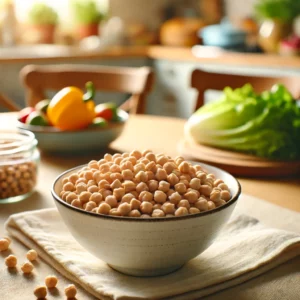chickpea snacks beneficial for diabetes and dieting
Welcome to our latest blog post where we delve into the benefits of chickpea snacks, a delightful treat for both diabetics and those on a diet. Known for their adorable shape and rich nutritional content, chickpeas are a powerhouse of protein and fiber, making them an excellent choice for managing blood sugar levels due to their low Glycemic Index (GI).
In this post, we will guide you through the simple steps of preparing these snacks by soaking, boiling, and frying chickpeas in healthy oils like avocado or olive oil to enhance their flavor and health benefits. We’ll also cover the best ways to store these crispy delights to ensure they remain fresh and tasty for days.
Ideal for everyone from kids looking for a nutritious snack to adults managing diabetes or weight, chickpea snacks are not only easy to make but also contribute significantly to a healthy diet. Join us as we explore how this fantastic snack can be a part of your healthy eating lifestyle.
chickpea snacks beneficial for diabetes and dieting

Introduction
Today, we’re exploring a snack that is beneficial for both diabetics and those on a diet: chickpea snacks. Chickpeas, with their cute shape and rich nutritional profile, are versatile enough to be used in a variety of dishes.

The Nutritional Value and Importance of Chickpeas
Chickpeas are abundant in protein and fiber, making them an effective food for managing blood sugar levels. They have a low Glycemic Index (GI), which helps in moderating blood sugar spikes, thus making them an ideal snack for people with diabetes or those trying to lose weight.
Making chickpea snacks
1. Chickpea Preparation: Start by thoroughly washing the chickpeas, then soak them in plenty of water for 5-6 hours. This step softens the chickpeas and allows them to absorb water and expand.
2. Cooking the Chickpeas: Transfer the soaked chickpeas to a large pot, cover with sufficient water, and boil for 20-30 minutes. Cook until the chickpeas are tender and can be easily mashed.
3. Frying the Chickpeas: Drain the chickpeas and transfer them to a frying pan. Add avocado oil or olive oil and fry the chickpeas over medium heat. Stir frequently to ensure even frying.
4. Adding Spices: As the chickpeas start to dry out and become crispy, add curry powder to enhance the flavor. Curry powder adds a savory taste and a fragrant aroma to the chickpeas. Continue frying to mix well.
5. Adding Honey: To further enhance the flavor, add a small amount of honey and fry a little longer. Honey softens the chickpeas and adds a slight sweetness. Ensure the honey is evenly distributed throughout the chickpeas.
6. Finishing: Once all ingredients are well combined and the chickpeas are crispy, turn off the heat and let the chickpeas cool. Once cooled, store them in an airtight container in the refrigerator and enjoy as needed.
These chickpea snacks are nutritious and tasty, making them an excellent choice for diabetics or those on a diet.
Finishing and Storage Methods
Once fried, allow the chickpeas to cool completely before storing them in an airtight container. This way, they can be kept fresh and enjoyed as a snack over several days. Chickpea snacks are not only easy to prepare but are also highly nutritious, making them suitable as a healthy snack option for children.
Conclusion
Chickpeas are a fantastic snack for blood sugar management and dieting. These snacks are simple to prepare and can significantly contribute to a healthy eating lifestyle. They are especially recommended for individuals with diabetes or those who are dieting. By incorporating chickpea snacks into your diet, you can maintain your health effectively.





